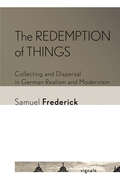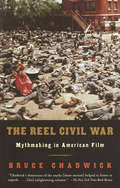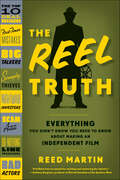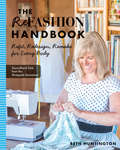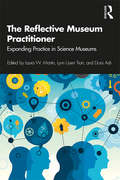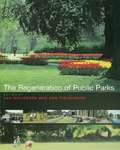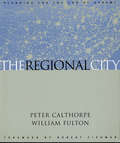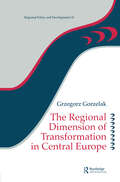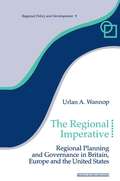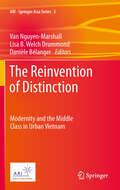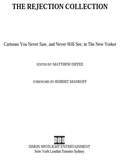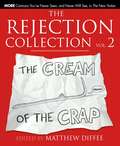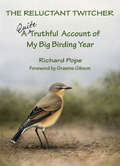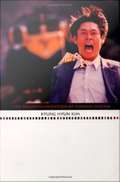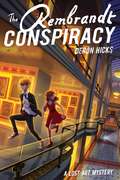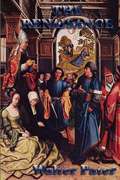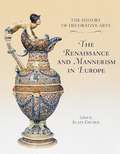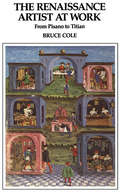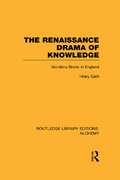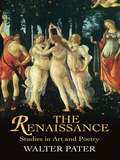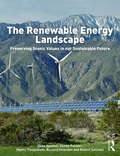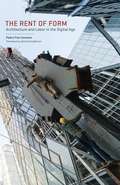- Table View
- List View
The Redemption of Things: Collecting and Dispersal in German Realism and Modernism (Signale: Modern German Letters, Cultures, and Thought)
by Samuel FrederickCollecting is usually understood as an activity that bestows permanence, unity, and meaning on otherwise scattered and ephemeral objects. In The Redemption of Things, Samuel Frederick emphasizes that to collect things, however, always entails displacing, immobilizing, and potentially disfiguring them, too. He argues that the dispersal of objects, seemingly antithetical to the collector's task, is essential to the logic of gathering and preservation. Through analyses of collecting as a dialectical process of preservation and loss, The Redemption of Things illustrates this paradox by focusing on objects that challenge notions of collectability: ephemera, detritus, and trivialities such as moss, junk, paper scraps, dust, scent, and the transitory moment. In meticulous close readings of works by Gotthelf, Stifter, Keller, Rilke, Glauser, and Frisch, and by examining an experimental film by Oskar Fischinger, Frederick reveals how the difficulties posed by these fleeting, fragile, and forsaken objects help to reconceptualize collecting as a poetic activity that makes the world of scattered things uniquely palpable and knowable.
The Reel Civil War: Mythmaking in American Film
by Bruce ChadwickArguing that film consistently distorts and sanitizes the past, Chadwick (history and film, Rutgers U.) details the distortions and myths purveyed by film from the KKK to the 1993 film in which actor Richard Gere plays a former slave-owner who is miraculously transformed into a populist who heroically drives off the KKK from a racially integrated community. For the bulk of film's history, myths have portrayed a myth of the underdog Southerner and demeaned African Americans, but new "politically correct," yet still sanitized, versions have begun to crop up in Hollywood productions. In the end, Chadwick seems to believe, despite changes in the treatment of the Civil war on screen, the "reel" still fails to be "real." Annotation c. Book News, Inc., Portland, OR (booknews.com)
The Reel Truth: Everything You Didn't Know You Need to Know About Making an Independent Film
by Reed MartinDid you know that most of the biggest indie filmmakers, screenwriters, and producers working today each made the same avoidable mistakes early on in their careers?The Reel Truth details the pitfalls, snares, and roadblocks that aspiring filmmakers encounter. Reed Martin interviewed more than one hundred luminaries from the independent film world to discuss the near misses that almost derailed their first and second films and identify the close shaves that could have cut their careers short. Other books may tell you the best way to make your independent film or online short, but no other book describes so candidly how to spot and avoid such issues and obstacles as equipment problems, shooting-day snafus, postproduction myths, theatrical distribution deal breakers, and dozens of other commonly made missteps, including the top fifty mistakes every filmmaker makes.From personal experience and his years as a freelance reporter covering independent film for USA Today and Filmmaker magazine, Martin uncovers the truth about the risks and potential rewards that go with chasing celluloid glory. Whether you're writing a screenplay, looking for financing, about to start shooting, or thinking about investing time and money (or someone else's money) in an independent film, The Reel Truth is a must-read.
The Refashion Handbook: Refit, Redesign, Remake for Every Body
by Beth HuntingtonTake secondhand finds from frumpy to fabulous with this guide by the Renegade Seamstress featuring resizing techniques and 19 refashioning projects.With her award-winning blog, The Renegade Seamstress, Beth Huntington combines two of her favorite activities—thrifting and sewing—into the art of refashioning. In The Refashion Handbook, she shares 19 stylish projects, each showing you how to transform easy-to-find items into a better fit, a new design, or a radical makeover. Learn the basics of refashioning: how to measure, reshape, fit, and finish a garment, so it fits you perfectly. Plus size? Petite? No problem! Beth's designs flatter a wide variety of sizes and body types. Her easy techniques are perfect for beginners and even experienced sewists will appreciated her clever tips and tricks.
The Reflective Museum Practitioner: Expanding Practice in Science Museums
by Laura W. Martin Lynn Uyen Tran Doris B. AshThe Reflective Museum Practitioner explores a range of expansive and creative ways in which the concept of “reflective practice” has been applied in the informal STEM (science, technology, engineering, and mathematics) learning environments of museums and zoos. It seeks to demonstrate how such a process can inspire lifelong learning in practitioners, to the benefit of practitioners and visitors alike. Presenting six projects that employed reflective practice, the contributors examine how each project has encouraged and sustained reflection, and the outcomes thereof. The projects cover a wide range of different practitioners—including administrators, scientists, educators, and other front-line and back-room staff—who work at different junctures of their organizations. Collectively, they raise key questions about changing communities of practice in Informal Science Learning institutions. The projects and concept of “reflective practice” are fully defined and contextualized by the editors, who offer in-depth analysis, along with a cultural-historical activity theory framework, for understanding how changes in museum practice unfold in an institutional context. The Reflective Museum Practitioner offers museum professionals insight into “reflective practice,” as practiced by other institutions in their sector, providing practical examples that can be adapted to their needs. It will also be of interest to scholars and students focusing on science museums, or professional practice development in museums.
The Regeneration of Public Parks
by Jan Woudstra Ken FieldhouseThe Urban Parks Programme, financed by the Heritage Lottery Fund, has sparked a new enthusiasm for the regeneration of Britain's parks. This unique reference book gives a valuable overview of all the elements of public park design. It emphasizes our parks' diversity and richness, and offers practical guidance as to their renovation and future care. It is essential reading for all those involved in the design, upkeep and regeneration of public parks.
The Regional City: Planning For The End Of Sprawl
by William Fulton Peter CalthorpeMost Americans today do not live in discrete cities and towns, but rather in an aggregation of cities and suburbs that forms one basic economic, multi-cultural, environmental and civic entity. These "regional cities" have the potential to significantly improve the quality of our lives--to provide interconnected and diverse economic centers, transportation choices, and a variety of human-scale communities. In The Regional City, two of the most innovative thinkers in the field of land use planning and design offer a detailed look at this new metropolitan form and explain how regional-scale planning and design can help direct growth wisely and reverse current trends in land use. The authors: *discuss the nature and underpinnings of this new metropolitan form *present their view of the policies and physical design principles required for metropolitan areas to transform themselves into regional cities *document the combination of physical design and social and economic policies that are being used across the country *consider the main factors that are shaping metropolitan regions today, including the maturation of sprawling suburbs and the renewal of urban neighborhoods Featuring full-color graphics and in-depth case studies, The Regional City offers a thorough examination of the concept of regional planning along with examples of successful initiatives from around the country. It will be must reading for planners, architects, landscape architects, local officials, real estate developers, community development professionals, and for students in architecture, urban planning, and policy.
The Regional Dimension of Transformation in Central Europe (Regions and Cities)
by Grzegorz GorzelakProviding a new picture of the socio-economic map of central Europe after several years of transformation, and focusing in particular on Poland, this book gives an account of the major problems of regional restructuring. The author identifies the opportunities and problems faced by particular regions by relating the Polish experience to the experience of other central European countries. This in turn provides a general picture of spatial patterns of transformation in this specific part of Europe and will interest those concerned with the transformation of Eastern Europe.
The Regional Imperative: Regional Planning and Governance in Britain, Europe and the United States (Regions and Cities #Vol. 9)
by Urlan A. WannopBased on cases and interviews in Britain, Europe and the United States, this book explains the recurrence of regional planning and of initiatives in regional governance, in a wide range of advanced industrial countries. Providing an analysis of the nature of regional planning and governance, the book traces the development of regional planning and the institutions associated with it. It also looks at the way that regions have been changing their form under pressure from economic and political developments and examines how regional planning and governance has responded, comparing experience in the UK, the rest of Europe and the US. In concluding that regionalism is an imperative feature of politics in most countries, associated with almost any of the variety of forms of governance, the author offers a major appraisal of the significance of regional planning in an intemational context
The Reinvention of Distinction
by Danièle Bélanger Lisa B. Drummond Van Nguyen-MarshallThis pioneering collection brings together an international group of scholars to explore the Vietnamese middle class. From the leisure pursuits of the colonial middle class to the impact of the new urban rich on landscape of the countryside, this interdisciplinary volume explores the ways in which middle classness has been practiced in a wide range of contexts throughout the 20th century and into the 21st. In addition to offering insights into how middle classness was and is constituted and negotiated, this collection illuminates the cultural and social conditions of two distinctive periods in Vietnamese history. Three historical chapters consider how middle class status was experienced and displayed under French colonialism and in 1960s republican. These chapters offer examinations of middle classness through recreation, consumption, and associational life. Six contemporary studies examine the modes of experimentation and practice within middle class urban Vietnam. Still a sensitive topic politically, the contemporary middle class, nascent but increasingly powerful, is exerting a strong impact on the shape of contemporary society and culture, as well as on urban and rural landscapes. This volume offers a series of studies which critically interrogate the practices of those who engage in or aspire to urban middle-class lifestyles in Vietnam both in the past and in the present.
The Rejection Collection
by Matthew Diffee Robert MankoffEach week about fifty New Yorker cartoonists submit ten ideas, yielding five hundred cartoons for no more than twenty spots in the magazine. Arguably the most brilliant single-panel-gag cartoonists in the world create a bunch of cartoons every week that never see the light of day. These rejects were piling up in the dusty corners of studios all over the country. Sam Gross, who has been contributing since 1962, has more than 12,000 rejected cartoons. (Seriously. He's been numbering every single cartoon he's ever submitted to The New Yorker since the very beginning.) Enter editor Matthew Diffee. He tapped his fellow cartoonists, asking them to rescue these hilarious lost gems. From the artists' stacks of all-time favorite rejects, Diffee handpicked the standouts -- the cream of the crap -- and created The Rejection Collection, a place where good ideas go when they die. Too risqué, silly, or weird for The New Yorker, the cartoons in this book offer something no other collection has: They have never been seen in print until now. With a foreword by New Yorker cartoon editor Robert Mankoff that explains the sound judgment, respectability, and scruples not found anywhere in these pages, and handwritten questionnaires that introduce the quirky character of each artist, The Rejection Collection will appeal to fans of The New Yorker...and to anyone with a slightly sick sense of humor.
The Rejection Collection Vol. 2
by Matthew DiffeeEach week The New Yorker receives more than five hundred submissions from its regular cartoonists, who are all vying for one of the twenty coveted spots in the magazine. So what happens to the 75 percent of cartoons that don't make the cut? Some go back in a drawer, others go up on the refrigerator or into the filing cabinet...but the very best of all the rejects can be found right here in these pages. The Rejection Collection Vol. 2: The Cream of the Crap is the ultimate scrap heap of creative misfires -- from the lowbrow and the dirty to the politically incorrect and the weird, these rejects represent the best of the worst...in the best possible sense of the word. Handpicked by editor Matthew Diffee, these hilarious cartoons are accompanied by handwritten questionnaires and photographed self-portraits, providing a rare glimpse into the minds of the artists behind the rejection. With appendices that explore the top ten reasons why cartoons are rejected and examine the solitary nature of the job of cartooning -- plus a special bonus section of questions asked of and answered by cartoon editor Robert Mankoff -- this sequel to The Rejection Collection offers even deeper insight into the exercise in frustration, patience, and amusement that is being a New Yorker cartoonist. Warped, wicked, and wildly funny, The Rejection Collection Vol. 2 will appeal to every New Yorker fan -- and everyone with a taste for the absurd.
The Reluctant Twitcher: A Quite Truthful Account of My Big Birding Year
by Richard PopeRichard Pope, author of Me n Len: Life in the Haliburton Bush, 1900-1940 and the voyageur epic Superior Illusions, is a recently retired professor of Russian literature and culture at York University and a long-standing member of the Ontario Ornithological Club and the Ontario Field Ornithologists. He and his wife, Felicity, live in Cobourg, Ontario. The human side of birding comes to the fore in The Reluctant Twitcher, a serious yet humorous account of birds and birding and the art of chasing rarities. Richard Pope, a lifelong birder, had successfully avoided this latter pursuit for many years but capitulated in 2007 when he embarked on his "Big Year," the object being to record at least three hundred birds in Ontario within that calendar period. Almost instantly, a relatively normal birdwatcher morphed into a "twitcher," albeit reluctantly, pursuing rare species of birds from Rainy River to the Ottawa and well beyond his wildest expectations. Though it was a challenge that was not without trials and disappointments, Pope describes all his adventures with self-deprecating humour. Not just another book on birding, Pope’s unique approach is supported by an array of exceptional colour photographs.
The Remasculinization of Korean Cinema
by Kyung Hyun KimIn one of the first English-language studies of Korean cinema to date, Kyung Hyun Kim shows how the New Korean Cinema of the past quarter century has used the trope of masculinity to mirror the profound sociopolitical changes in the country. Since 1980, South Korea has transformed from an insular, authoritarian culture into a democratic and cosmopolitan society. The transition has fueled anxiety about male identity, and amid this tension, empowerment has been imagined as remasculinization. Kim argues that the brutality and violence ubiquitous in many Korean films is symptomatic of Korea's on-going quest for modernity and a post-authoritarian identity. Kim offers in-depth examinations of more than a dozen of the most representative films produced in Korea since 1980. In the process, he draws on the theories of Jacques Lacan, Slavoj Zizek, Gilles Deleuze, Rey Chow, and Kaja Silverman to follow the historical trajectory of screen representations of Korean men from self-loathing beings who desire to be controlled to subjects who are not only self-sufficient but also capable of destroying others. He discusses a range of movies from art-house films including To the Starry Island (1993) and The Day a Pig Fell into the Well (1996) to higher-grossing, popular films like Whale Hunting (1984) and Shiri (1999). He considers the work of several Korean auteurs--Park Kwang-su, Jang Sun-woo, and Hong Sang-su. Kim argues that Korean cinema must begin to imagine gender relations that defy the contradictions of sexual repression in order to move beyond such binary struggles as those between the traditional and the modern, or the traumatic and the post-traumatic.
The Rembrandt Conspiracy (The Lost Art Mysteries)
by Deron R. HicksIn this standalone companion to The Van Gogh Deception, Art and Camille team up once again to solve a large museum theft, using one of the biggest heists in history to help them solve the case. Perfect for fans of Dan Brown and the Mr. Lemoncello's Library and Book Scavenger series. Something&’s brewing at the National Portrait Gallery Museum in Washington, D.C. twelve-year-old Art is sure of it. But his only proof that a grand heist is about to take place is iced mocha, forty-two steps, and a mysterious woman who appears like clockwork in the museum. When Art convinces his best friend, Camille, that the heist is real, the two begin a thrilling chase through D.C. to uncover a villainous scheme that could be the biggest heist since the Isabelle Stewart Gardner Museum theft in 1990. With a billion dollars&’ worth of paintings on the line, the clock is ticking for Art and Camille to solve the conspiracy.
The Renaissance
by Walter PaterPater's graceful essays discuss the achievements of Botticelli, Leonardo, Michelangelo, and other artists. Included is his celebrated discussion of the Mona Lisa in a study of Da Vinci. This book concludes with an uncompromising advocacy of hedonism, urging readers to experience life as fully as possible. His cry of "art for art's sake" became the manifesto of the Aesthetic Movement, and his assessments of Renaissance art have influenced generations of readers. Oscar Wilde called this collection of essays the "holy writ of beauty."
The Renaissance And Mannerism In Europe
by John Goodman Alain Gruber Margherita Azzi-Visentini Jacques Thuillier Michele Bimbenet-PrivatThe first volume in a three-volume set devoted to the history of decorative arts from the 15th to the early 20th century. It is a massive, beautifully produced work, translated from the original French edition (1993, Editio-Editions Citadelles & Mazenod, Paris), and covering the period from about 14
The Renaissance Artist At Work: From Pisano To Titian
by Bruce ColeThis book gives the necessary background for the study and appreciation of Italian painting and sculpture from about 1250 to 1550. It tells how the artists learned their craft, the organization of their workshops, and the guilds they belonged to; how their customers or patrons treated them and where their work was displayed?churches, civic buildings, or private homes. The book discusses how art was made?tempera, oil, panel, canvas, fresco; it surveys the characteristic types of Renaissance art?altarpieces, portraits, tombs, busts, doors fountains, medals, etc.
The Renaissance Drama of Knowledge: Giordano Bruno in England (Routledge Library Editions: Alchemy)
by Hilary GattiGiordano Bruno’s visit to Elizabethan England in the 1580s left its imprint on many fields of contemporary culture, ranging from the newly-developing science, the philosophy of knowledge and language, to the extraordinary flowering of Elizabethan poetry and drama. This book explores Bruno's influence on English figures as different as the ninth Earl of Northumberland, Thomas Harriot, Christopher Marlowe and William Shakespeare. Originally published in 1989, it is of interest to students and teachers of history of ideas, cultural history, European drama and renaissance England. Bruno's work had particular power and emphasis in the modern world due to his response to the cultural crisis which had developed - his impulse towards a new ‘faculty of knowing’ had a disruptive effect on existing orthodoxies – religious, scientific, philosophical, and political.
The Renaissance: Studies in Art and Poetry
by Walter Horatio PaterA discussion of Renaissance art and poetry from a 19th-century author with scholarly annotations.
The Renaissance: Studies in Art and Poetry (Dover Fine Art, History Of Art Series)
by Walter PaterPublished to equal parts scandal and acclaim in 1873, The Renaissance inspired a generation of Oxford undergraduates, who adapted its credo of "arts for art's sake" for their Aesthetic Movement. Combining the skepticism of empirical philosophy, the materialism of 19th-century science, and the determinism of evolutionary theory, this book defies categorization and endures as an innovative example of cultural criticism.An Oxford don who led a quiet scholarly life, Walter Pater was shocked at the reactions his writings provoked. ("I wish they would not call me a hedonist," he remarked, "it gives such a wrong impression to those who do not know Greek.") His essays on the individuals he viewed as embodiments of the Renaissance spirit encompass artists whose careers span the Middle Ages through the 18th century. Pater's elegant, fluid prose examines the works of Pico della Mirandola, Leonardo, Michelangelo, Botticelli, and others. He crowns his compendium of reflections with his notorious Conclusion, in which he asserts that "to burn always with this hard, gemlike flame, to maintain this ecstasy, is success in life."One of Victorian England's most talked about books, The Renaissance exerted a crucial influence on the art criticism of the past century, and it remains a work of unusual importance to those interested in art history and English literature.
The Renewable Energy Landscape: Preserving Scenic Values in our Sustainable Future
by James Palmer Robert Sullivan Richard Smardon Dean Apostol Martin PasqualettiWinner of the 2017 EDRA Great Places Award (Research Category) Winner of the 2017 VT ASLA Chapter Award of Excellence (Communications Category) The Renewable Energy Landscape is a definitive guide to understanding, assessing, avoiding, and minimizing scenic impacts as we transition to a more renewable energy future. It focuses attention, for the first time, on the unique challenges solar, wind, and geothermal energy will create for landscape protection, planning, design, and management. Topics addressed include: Policies aimed at managing scenic impacts from renewable energy development and their social acceptance within North America, Europe and Australia Visual characteristics of energy facilities, including the design and planning techniques for avoiding or mitigating impacts or improving visual fit Methods of assessing visual impacts or energy projects and the best practices for creating and using visual simulations Policy recommendations for political and regulatory bodies. A comprehensive and practical book, The Renewable Energy Landscape is an essential resource for those engaged in planning, designing, or regulating the impacts of these new, critical energy sources, as well as a resource for communities that may be facing the prospect of development in their local landscape.
The Renewable Energy Landscape: Preserving Scenic Values in our Sustainable Future
by James Palmer Robert Sullivan Richard Smardon Dean Apostol Martin PasqualettiWinner of the 2017 EDRA Great Places Award (Research Category)Winner of the 2017 VT ASLA Chapter Award of Excellence (Communications Category)The Renewable Energy Landscape is a definitive guide to understanding, assessing, avoiding, and minimizing scenic impacts as we transition to a more renewable energy future. It focuses attention, for the first time, on the unique challenges solar, wind, and geothermal energy will create for landscape protection, planning, design, and management.Topics addressed include: Policies aimed at managing scenic impacts from renewable energy development and their social acceptance within North America, Europe and Australia Visual characteristics of energy facilities, including the design and planning techniques for avoiding or mitigating impacts or improving visual fit Methods of assessing visual impacts or energy projects and the best practices for creating and using visual simulations Policy recommendations for political and regulatory bodies A comprehensive and practical book, The Renewable Energy Landscape is an essential resource for those engaged in planning, designing, or regulating the impacts of these new, critical energy sources, as well as a resource for communities that may be facing the prospect of development in their local landscape.
The Rent of Form: Architecture and Labor in the Digital Age (Buell Center Books in the History and Theory of American Architecture)
by Pedro Fiori ArantesA critique of prominent architects&’ approach to digitally driven design and labor practices over the past two decades With the advent of revolutionary digital design and production technologies, contemporary architects and their clients developed a taste for dramatic, unconventional forms. Seeking to amaze their audiences and promote their global brands, &“starchitects&” like Herzog & de Meuron and Frank Gehry have reaped substantial rewards through the pursuit of spectacle enabled by these new technologies. This process reached a climax in projects like Gehry&’s Guggenheim Bilbao and the &“Bilbao effect,&” in which spectacular architectural designs became increasingly sought by municipal and institutional clients for their perceived capacity to enhance property values, which author Pedro Fiori Arantes calls the &“rent of form.&”Analyzing many major international architectural projects of the past twenty years, Arantes provides an in-depth account of how this &“architecture of exception&” has come to dominate today&’s industry. Articulating an original, compelling critique of the capital and labor practices that enable many contemporary projects, Arantes explains how circulation (via image culture), consumption (particularly through tourism), the division of labor, and the distribution of wealth came to fix a certain notion of starchitecture at the center of the industry.Significantly, Arantes&’s viewpoint is not that of Euro-American capitalism. Writing from the Global South, this Brazilian theorist offers a fresh perspective that advances ideas less commonly circulated in dominant, English-language academic and popular discourse. Asking key questions about the prevailing logics of finance capital, and revealing inconvenient truths about the changing labor of design and the treatment of construction workers around the world, The Rent of Form delivers a much-needed reevaluation of the astonishing buildings that have increasingly come to define world cities.
The Repair Shop Puzzle Book: Train your brain with puzzles inspired by the Repair Shop barn
by The Repair ShopThe first puzzle book based on the BAFTA-award-winning television show The Repair Shop, with a foreword from The Repair Shop clocks expert Steve Fletcher.Think you know about the Repair Shop, its crafts, craftspeople and stories? Looking for fun brainteasers, word games and quizzes to train your brain and hone your problem solving skills? It's time to put your knowledge to the test with this collection of questions and puzzles designed to challenge and entertain.Blending together basic trivia, complex wordplay and a range of visual teasers, the book calls on the knowledge of Repair Shop fans to provide hours of challenges inspired by the iconic barn and the work that goes on inside. From silversmithing and woodworking, to teddy bears, clocks and paintings, the puzzles draw on the wide range of skills and objects that the Repair Shop team are famed for.With difficulty levels varying from pleasantly tricky to fiendishly hard, The Repair Shop Puzzle Book will delight all fans of the show.
